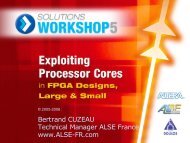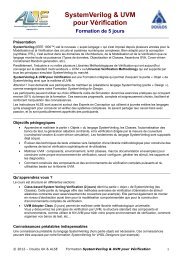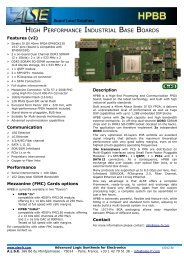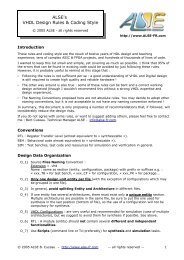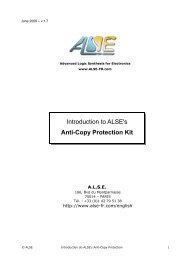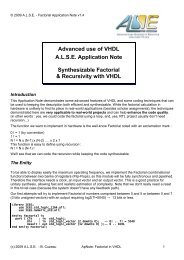learn about RS232 and how to code a UART - ALSE
learn about RS232 and how to code a UART - ALSE
learn about RS232 and how to code a UART - ALSE
Create successful ePaper yourself
Turn your PDF publications into a flip-book with our unique Google optimized e-Paper software.
Data Format<br />
Baud rate<br />
Very old systems used 1200 bauds, a speed that practically all equipments were able <strong>to</strong> reach, so it was<br />
long considered as a nice fall back speed, or the lowest speed that was needed <strong>to</strong> implement.<br />
9600 bauds was a quite popular speed, <strong>and</strong> 115,200 bauds was the highest speed supported by most<br />
equipments <strong>and</strong> became quite popular on PCs (external 33k6 modem links).<br />
Data Length<br />
Many values are possible, but the most popular formats are 7 bits (obsolete) or 8 bits.<br />
Parity<br />
When some data integrity checking is desired, parity can be added. However, a much better checking is<br />
obtained when the characters are accumulated in a checksum or -even better- in a CRC checker.<br />
So the use of parity has never been extremely popular (it still left 50% of chances that a wrong character<br />
went undetected).<br />
The “parity” could also be a fixed 0 or 1 value for all characters (not very coherent with the name “parity”),<br />
but this was even less popular (<strong>and</strong> useful) than the true odd or even parity.<br />
The Table below does summarize the different possibilities with respect <strong>to</strong> Parity.<br />
Parity<br />
Value of last bit transmitted before s<strong>to</strong>p bit<br />
EVEN 1 if the data transmitted has an even amount of 0 bits.<br />
ODD 1 if the data transmitted has an odd amount of 0 bits.<br />
MARK 1<br />
SPACE 0<br />
NONE No parity bit is transmitted. Most popular option.<br />
S<strong>to</strong>p Bit(s)<br />
There is no maximum space between characters, the pro<strong>to</strong>col is asynchronous <strong>and</strong> the line could stay<br />
Idle for any length of time. However, the minimum space separating characters is part of the definition of<br />
the format. It is typically 1 bit, but can be also 1.5 or 2 bits. My personal preference goes 1.5 bits which<br />
facilitates the resynchronization in a continuous stream <strong>and</strong> visual inspection (<strong>and</strong> is compatible with a 1<br />
s<strong>to</strong>p bit receiver).<br />
Rule : a Transmitter can have more s<strong>to</strong>p bits than the receiver (but it doesn't work the other way).<br />
Transmission Format Notation<br />
<strong>RS232</strong> Transmission format is often abridged under the form : “Speed-Parity-Data bits-S<strong>to</strong>p bits”.<br />
Example : “115200-N-8-1” means 115,200 bauds, No parity, 8 data bits, 1 s<strong>to</strong>p bit.<br />
Other example : “1200E71” (I think it was the old French Minitel format).<br />
© 2009 A.L.S.E. - B. Cuzeau ApNote: <strong>RS232</strong> Basics 2



